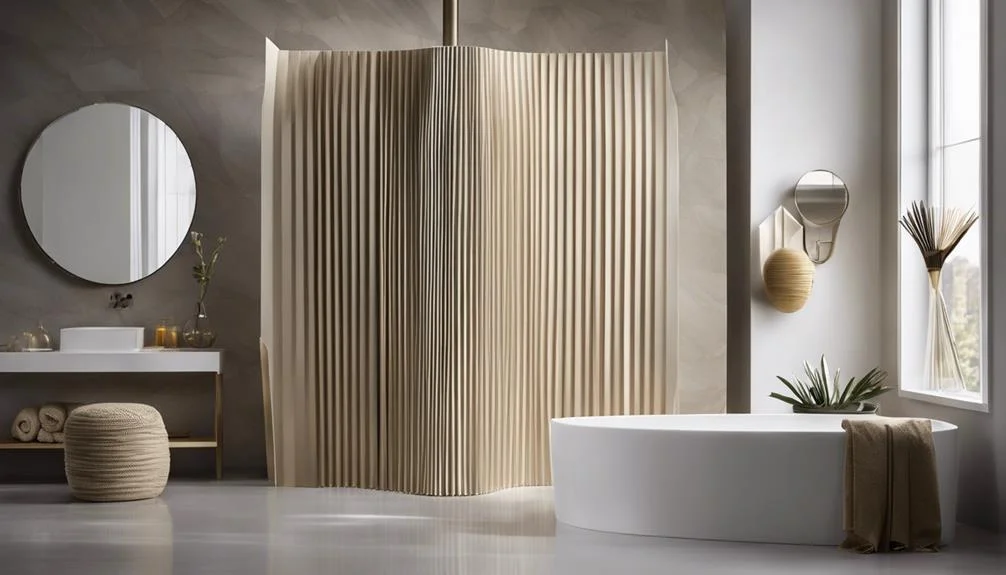Aspen wood boasts a light color, smooth texture, and ease of manipulation for various projects due to its softness and straight grain. However, it requires regular maintenance to combat its susceptibility to rot and decay caused by moisture. While its workability is a clear advantage, Aspen's limited strength and durability may lead to dents and scratches over time. If you're considering Aspen wood for your next project, understanding both its advantages and drawbacks can assist you in making an informed decision.
Takeaways
- Easy workability for precise woodworking projects.
- Light color and smooth texture for versatile designs.
- Susceptible to dents and scratches, requiring regular maintenance.
- Economical choice with limited strength and shorter lifespan.
- Eco-friendly option due to sustainability and renewability.
Light Color and Smooth Texture
Aspen wood is characterized by its light color and smooth texture, making it a popular choice for various woodworking projects. Its pale white to light brown hue brings a sense of brightness and airiness to any space it adorns, making it ideal for creating a clean and modern aesthetic.
The smooth texture of aspen wood further enhances its appeal, allowing for easy staining and finishing to achieve a polished look.
Craftsmen and woodworkers often favor aspen wood for projects that require a light and natural appearance, such as furniture, cabinets, and decorative items. Its ability to take on a variety of finishes, from clear varnishes to colorful stains, offers versatility in design possibilities.
The uniform grain of aspen wood also lends itself well to painting and intricate detailing, making it a suitable choice for intricate woodworking projects.
In addition to its aesthetic appeal, the light color and smooth texture of aspen wood make it a popular option for creating a sense of openness and brightness in interior spaces. Its versatility, combined with its visual appeal, positions aspen wood as a preferred material for both professional woodworkers and DIY enthusiasts.
Easy to Work With
Aspen wood's easy workability makes it a favorite among woodworkers, allowing for seamless cutting, shaping, and finishing.
Its versatility in various projects, from intricate carvings to simple furniture making, showcases its adaptability and user-friendly nature.
With the potential for a smooth finish, aspen wood offers both amateur and professional craftsmen a satisfying woodworking experience.
Workability of Aspen
The workability of aspen wood is often praised for its ease of manipulation and smoothness when crafting various woodworking projects. Woodworkers and craftsmen appreciate the following aspects of aspen wood:
- Soft and Lightweight: Aspen is a relatively soft hardwood, making it easy to cut, shape, and carve with standard woodworking tools. Its lightweight nature allows for effortless handling, reducing fatigue during extended periods of crafting.
- Minimal Splintering: Aspen's fine texture and straight grain contribute to its minimal splintering tendencies, ensuring a clean and smooth finish on woodworking projects. This characteristic simplifies the sanding and finishing processes, saving time and effort for craftsmen.
- Gluing and Staining Capabilities: Aspen wood readily accepts adhesives and stains, making it versatile for a wide range of woodworking applications. Its ability to hold glue securely and evenly absorb stains results in professional-looking and durable final products.
Versatile for Projects
How does the workability of aspen wood contribute to its versatility for a wide range of woodworking projects?
Aspen wood's excellent workability is a key factor in its versatility for various woodworking projects. The softness and even texture of aspen make it easy to manipulate using both hand and power tools. Its low density and straight grain allow for smooth cuts and shaping, making it ideal for intricate designs and detailed work.
Due to its ease of workability, aspen wood is popular among craftsmen and DIY enthusiasts for a wide range of projects such as furniture making, cabinetry, carving, and turning. Its ability to hold intricate details and patterns without splintering or chipping makes it a preferred choice for projects that require precision and fine craftsmanship.
Moreover, the lightweight nature of aspen wood further enhances its versatility, as it can be used in projects where weight is a concern or when portability is key. Whether it's creating delicate carvings or sturdy furniture pieces, the workability of aspen wood makes it a valuable material for woodworking projects of all kinds.
Smooth Finish Potential
Achieving a smooth finish with aspen wood is facilitated by its exceptional ease of manipulation and adaptability to various woodworking techniques. Aspen's soft texture allows craftsmen to work with it effortlessly, making it ideal for achieving a flawless, polished surface on woodworking projects.
Here are three reasons why aspen wood's smooth finish potential makes it a top choice for woodworkers:
- Ease of Sanding: Aspen wood's consistent grain structure and softness make it easy to sand down, ensuring a smooth and even surface without much effort. This feature saves time and energy during the finishing process, providing woodworkers with a more efficient workflow.
- Acceptance of Stains and Finishes: Aspen wood readily accepts stains and finishes, allowing woodworkers to customize the appearance of their projects easily. This versatility in finishing options enhances the aesthetic appeal of the final piece, showcasing the natural beauty of aspen wood.
- Uniform Texture: The uniform texture of aspen wood contributes to a seamless finish, minimizing the appearance of blemishes or imperfections on the surface. This characteristic results in a professional-looking end product that is visually pleasing and showcases the craftsmanship involved.
Affordable and Readily Available
Aspen wood stands out in the market due to its affordability and widespread availability. This type of wood is known for being a cost-effective option for various woodworking projects. Compared to other hardwoods, aspen wood is relatively inexpensive, making it an attractive choice for budget-conscious consumers. Its affordability does not compromise its quality, as aspen wood is still durable and versatile.
Moreover, aspen wood is readily available in many regions, making it easy to source for both small and large-scale projects. Its widespread availability guarantees that consumers can easily find this type of wood at local hardware stores or lumberyards. This accessibility also contributes to its affordability, as transportation costs are lower due to its abundance in many areas.
Prone to Dents and Scratches
When considering aspen wood for furniture or flooring, it is essential to note its susceptibility to dents and scratches. While aspen is known for its lightweight and soft characteristics, this can also make it more prone to damage from everyday wear and tear.
Understanding the durability challenges and maintenance requirements of aspen wood is vital for making informed decisions about its use in various applications.
Durability of Aspen
The durability of aspen wood is notably compromised by its susceptibility to dents and scratches, making it less ideal for high-traffic areas or heavy-duty furniture. While aspen wood offers a light and airy aesthetic appeal, its soft nature leaves it vulnerable to damage from everyday use.
Here are some key points to ponder regarding the durability of aspen wood:
- Fragility: Aspen wood is prone to denting and scratching more easily than harder woods, which can lead to a weathered appearance over time.
- Maintenance: Regular upkeep such as applying protective coatings or using furniture pads is essential to prolong the lifespan of aspen wood furniture.
- Impact on Longevity: The susceptibility of aspen wood to dents and scratches can affect the longevity of furniture pieces made from this material, requiring more frequent repairs or replacements.
Considering these factors, it is important to weigh the aesthetic appeal of aspen wood against its durability limitations when choosing furniture for specific environments.
Maintenance Challenges
Given its susceptibility to dents and scratches, maintaining aspen wood furniture presents notable challenges. Aspen wood, while valued for its light color and smooth texture, is relatively soft compared to other hardwoods. This softness makes it more prone to dents and scratches from everyday use.
To mitigate these maintenance challenges, several strategies can be employed. One approach is to apply protective coatings such as varnish or polyurethane to create a barrier that helps shield the wood from damage. Regularly inspecting the furniture for any signs of wear and tear can also help catch minor issues before they worsen. Additionally, using furniture pads or coasters under heavy objects can prevent dents and scratches caused by friction.
Despite these precautions, it's essential to acknowledge that maintaining aspen wood furniture will require ongoing care and attention. While dents and scratches may be inevitable due to the wood's inherent properties, proactive maintenance efforts can prolong the lifespan and aesthetic appeal of aspen wood furniture.
Susceptible to Rot and Decay
Aspen wood's susceptibility to rot and decay poses a significant challenge for its long-term durability in outdoor applications. When considering this aspect of aspen wood, it is important to acknowledge the following points:
- Vulnerability to Moisture: Aspen wood's high moisture content makes it prone to rot when exposed to damp or wet conditions for extended periods. This susceptibility to moisture can lead to fungal growth and structural weakening over time.
- Limited Natural Defenses: Unlike some other hardwoods, aspen lacks natural oils or resins that provide protection against decay-causing organisms. This absence of protective compounds leaves aspen more exposed to the elements and increases the likelihood of decay.
- Maintenance Intensive: Due to its susceptibility to rot, aspen wood requires frequent maintenance, including sealing, staining, or painting to enhance its longevity. This ongoing maintenance can be time-consuming and costly, making it a less desirable option for outdoor projects where durability is paramount.
Limited Strength and Durability
Despite its lightweight nature, aspen wood's structural integrity and long-term durability are often compromised due to its limited strength and susceptibility to damage. Aspen wood is known for being less dense and softer compared to other hardwoods, making it prone to dents, scratches, and overall wear and tear. This limited strength can result in the wood being easily damaged by impacts or heavy loads, reducing its lifespan and structural reliability.
| Pros | Cons |
|---|---|
| Lightweight | Limited strength |
| Easily workable | Susceptible to damage |
| Economical | Prone to dents and scratches |
| Eco-friendly | Shorter lifespan |
In construction and furniture making, the limited strength of aspen wood can be a significant drawback, especially in applications where robustness and durability are essential. While its lightweight properties can be advantageous for certain projects, the trade-off regarding strength and longevity may outweigh the benefits for many practical purposes. Therefore, understanding the limitations of aspen wood is important when considering it for various woodworking projects.
Frequently Asked Questions
Can Aspen Wood Be Stained or Painted Easily?
Aspen wood can be stained or painted easily due to its smooth texture and uniform grain. Proper preparation, such as sanding and priming, is essential to guarantee a lasting finish. Choose appropriate products for best results.
How Does Aspen Wood Handle Outdoor Conditions?
Aspen wood is not recommended for outdoor use due to its susceptibility to decay, warping, and rot when exposed to moisture and sunlight. It is best suited for indoor applications to maintain its integrity.
Is Aspen Wood Suitable for High-Traffic Areas?
Aspen wood, while generally not recommended for high-traffic areas due to its softer nature, can still be used with proper maintenance and protective measures. Consider durability requirements and potential wear and tear before choosing aspen for such spaces.
Does Aspen Wood Require Special Maintenance?
Aspen wood typically requires regular maintenance to preserve its appearance and longevity. This maintenance may include periodic sanding, sealing, and refinishing to protect the wood from wear and tear, moisture damage, and other environmental factors.
Can Aspen Wood Be Used for Structural Purposes?
Aspen wood can be used for structural purposes due to its lightweight nature and flexibility. It is commonly employed in furniture, cabinets, and interior construction. However, its softness may require additional support for heavy-duty structural applications.
Conclusion
To sum up, when evaluating aspen wood, it is essential to take into account its:
- Light color
- Smooth texture
- Ease of workability
- Affordability
- Availability
However, it is crucial to bear in mind its:
- Vulnerability to dents and scratches
- Proneness to rot and decay
- Limited strength and durability
Ultimately, the decision to use aspen wood should be based on the specific needs and requirements of the project at hand.









